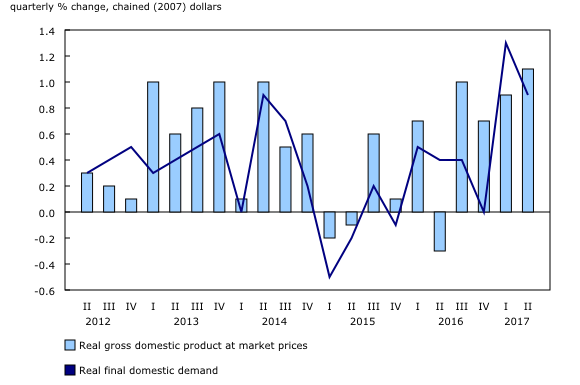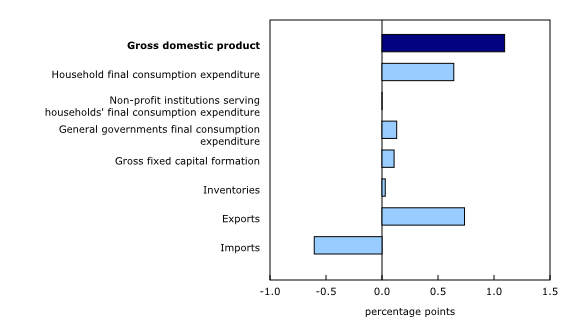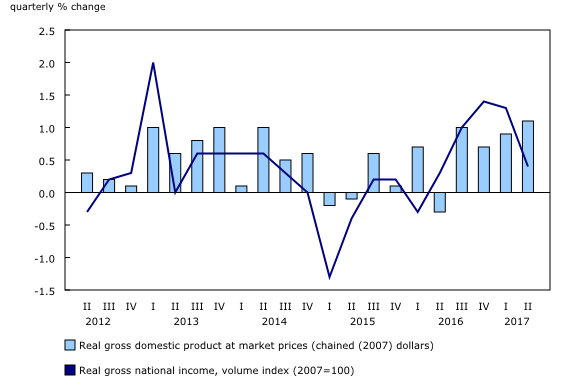Gross domestic product, income and expenditure, second quarter 2017
Archived Content
Information identified as archived is provided for reference, research or recordkeeping purposes. It is not subject to the Government of Canada Web Standards and has not been altered or updated since it was archived. Please "contact us" to request a format other than those available.
Released: 2017-08-31
Real gross domestic product (GDP) rose 1.1% in the second quarter, following a 0.9% gain in the first quarter. The cumulative growth in the first two quarters of the year (+2.0%) was the strongest since 2002 (+2.1%). Household final consumption expenditure and exports of goods were important contributors to second quarter growth.
Real gross national income, a measure of the purchasing power of productive income earned by Canadian residents, advanced a more modest 0.4% in the second quarter, constrained by worsening terms of trade. Export prices increased 0.5%, while import prices rose 2.7% in tandem with a depreciating Canadian dollar.
Household spending on goods advanced 1.9%, with outlays on durables, semi-durables and non-durables all increasing. Outlays on services rose 0.5%. Overall, household final consumption expenditure advanced 1.1% in the second quarter, after increasing 1.2% the previous quarter.
Growth in export volumes accelerated to 2.3% following a 0.4% gain in the first quarter. Exports of goods rose 2.8%, with energy products (+9.2%) contributing the most to the increase. Exports of services edged down 0.1% as commercial services fell 0.6%.
Imports rose 1.8%, about half the pace of the previous quarter. Imports of goods increased 2.5% while those of services declined 1.0%.
Business gross fixed capital formation slowed to 0.5% growth, following a 3.1% increase in the first quarter. The deceleration was mostly attributable to lower investment in housing (-1.2%). Business investment in non-residential structures rose 2.4% after increasing 1.0% in the first quarter.
Businesses accumulated another $11.5 billion in inventories in the second quarter, after adding $10.5 billion to their stocks in the first. Despite the strong inventory accumulation, the stock-to-sales ratio declined 0.8%.
Expressed at an annualized rate, real GDP rose 4.5% in the second quarter. In comparison, real GDP in the United States grew 3.0%.
Household spending increases
Household final consumption expenditure grew 1.1%, following a 1.2% increase the previous quarter.
Outlays on goods rose 1.9%, the strongest gain since the second quarter of 2007. The growth was evidenced in durable goods (+2.3%), semi-durable goods (+3.9%) and non-durable goods (+1.1%). Spending on services increased 0.5%.
Transport (+1.9%) contributed the most to the growth in household spending, as the purchase of vehicles rose 2.0%. Housing, water, electricity, gas and other fuels (+0.9%) and clothing and footwear (+5.0%) also contributed to the increase.
Housing market weakens
Investment in residential structures fell 1.2%, following a 2.9% increase the previous quarter. The decrease was due to a sharp decline in ownership transfer costs (-6.7%). A new tax on home purchases by non-residents in Ontario came into effect in April. Renovations increased 1.1% while new housing construction investment was virtually unchanged.
Exports rise
Exports of goods and services rose 2.3% in the second quarter, with an increase in the exports of goods (+2.8%) moderated by a decline in services (-0.1%).
The increase in exports was in large part due to significant growth in exports of energy products (+9.2%). Export volumes of crude oil and crude bitumen increased 7.4% in the second quarter, however prices fell, constraining the earnings of crude oil producers. Exports of natural gas, natural gas liquids and related products rose 14.4%. Industrial machinery, equipment and parts (+8.2%) was also an important contributor to export growth.
Imports grew 1.8%, led by higher imports of goods (+2.5%) and tempered by lower imported services (-1.0%)
Growth in imports was led by an increase in aircraft and other transportation equipment and parts (+13.0%) with contributions from energy products (+8.4%) and motor vehicles and parts (+1.8%). The increase was partially offset by a decline in commercial services (-2.7%).
Business investment increases
Business gross fixed capital formation rose 0.5% in the second quarter, following a 3.1% increase in the first quarter.
Investment in non-residential structures grew 2.4%, after increasing 1.0% in the first quarter. The growth was largely attributable to engineering structures (+3.2%), while investment in non-residential buildings was virtually unchanged.
Intellectual property products (+2.1%) grew for the second straight quarter. Increased investment in mineral exploration and evaluation (+17.9%), on top of strong growth in the first quarter, continued the recovery following steady declines throughout 2015 and 2016. Research and development (+0.2%) edged up while software was flat.
Investment in machinery and equipment grew 0.9%, following a 6.6% increase the previous quarter. Growth in aircraft and other transportation equipment (+13.2%) was partially offset by a decline in industrial machinery and equipment (-0.9%).
Business inventories rise
Businesses' inventories rose by $11.5 billion in the second quarter, following a $10.5 billion increase the previous quarter.
Non-farm inventories rose by $13.0 billion, as stocks in manufacturing (+$3.3 billion), trade (+$8.8 billion) and other non-farm (+$1.9 billion) inventories all increased. Farm inventory stocks were reduced by $892 million. Drawdowns in inventories of grain (-$279 million) and other crops (-$459 million) were the main contributors.
Retailers' inventories of durable goods rose by $1.4 billion, despite a drawdown in motor vehicle inventories (-$76 million). Stocks of non-durable goods increased by $2.0 billion. Wholesalers accumulated inventories in both durable (+$3.0 billion) and non-durable (+$2.3 billion) goods.
The economy-wide stock-to sales ratio declined from 0.748 in the first quarter to 0.742 in the second quarter.
Household saving unchanged
Compensation of employees grew 0.8% in the second quarter (nominal terms), following a 1.0% gain in the first quarter. Wages and salaries rose 0.8% as an increase in services-producing industries (+1.1%) more than offset a decline in goods-producing industries (-0.1%).
The household saving rate rose from 4.3% in the first quarter to 4.6% in the second quarter, as household disposable income (+1.6%) outpaced household final consumption expenditure (+1.1%).
The household debt service ratio (defined as household mortgage and non-mortgage payments divided by disposable income) was unchanged from the first quarter figure of 14.15%.
Corporate earnings edge down
The gross operating surplus of corporations edged down 0.1% in the second quarter. Gross operating surplus of non-financial corporations grew 0.3%, a fourth consecutive quarterly gain. Financial corporations' gross operating surplus fell a further 4.7% following a 0.9% decline in the first quarter.
Real gross national income increased 0.4% as worsening terms of trade constrained growth. Export prices grew 0.5% while import prices rose 2.7%. The implicit price of final domestic demand increased 0.3%, while the GDP implicit price index (the price of goods and services produced in Canada) declined 0.3%.

In celebration of the country's 150th birthday, Statistics Canada is presenting snapshots from our rich statistical history.
Today, we look at the evolution of gross national income (GNI) since 1961.
In addition to domestic production, the real purchasing power of a nation's income is influenced by three factors: the prices of exported and imported products, exchange rates and the inflow of labour and investment income from abroad less the outflow of income to foreigners.
By incorporating these factors, real GNI captures a nation's true purchasing power, which is not fully reflected by real gross domestic product (GDP). Real GDP measures the volume of production from within a country's geographical boundary. In nominal terms, GDP and GNI are equal in the absence of international transactions. Real GNI takes into account changes in the terms of trade (the ratio of export to import prices) and exchange rates to reflect the purchasing power earned by Canadian-owned factors of production.
From 1961 to 2016, the annual growth rates of real GDP and real GNI averaged 3.15% and 3.22% respectively, indicating that over the long term, the net impact of those factors have tended to be insignificant in Canada.
In the short term, however, the two measures can diverge substantially. In 1998, for instance, a 6.8% drop in the exchange rate (CAN$1.00=US$0.67) in the aftermath of the East-Asian financial crisis, dampened real GNI growth to 2.0% compared with a 3.9% increase in real GDP. In 2008, primarily owing to the high prices of exported products including oil, real GNI rose 2.5%, whereas real GDP grew 1.0%, implying that the country could purchase more goods and services than it produced in that period.
In 2009, real GNI fell 6.2%, but real GDP declined by only 3.0%. The sharper drop in GNI captures the loss in purchasing power due to a sudden drop in commodity prices in the wake of the global financial crisis, while prices of major import items (including motor vehicles and parts) were relatively stable. The divergence indicates that the nation was worse off than indicated by the drop in real GDP.
In 2010, 2011 and 2013, real GNI grew faster than real GDP, as international factors were favourable for the income of Canada. In 2013, for instance, a 10.6% decrease in net-income outflow contributed to real GNI, which grew by 2.7% compared with a 2.5% growth of real GDP. From 2014 to 2016, with the fall in oil prices again, the reverse occurred.
By combining domestic and foreign factors, real GNI provides a distinct signal in periods of volatility in exchange rates, prices of traded products, and net-inflow of incomes. Consequently, to undertake informed economic analysis, real GNI should be considered in conjunction with real GDP.
Note to readers
For information on seasonal adjustment, see Seasonally adjusted data – Frequently asked questions.
Percentage changes for expenditure-based statistics (such as personal expenditures, investment, exports and imports) are calculated from volume measures that are adjusted for price variations. Percentage changes for income-based and flow-of-funds statistics (such as labour income, corporate profits, mortgage borrowing and total funds raised) are calculated from nominal values; that is, they are not adjusted for price variations.
There are two ways of expressing growth rates for gross domestic product (GDP) and other time series found in this release:
- Unless otherwise stated, the growth rates in this release represent the percentage change in the series from one quarter to the next, such as from the first quarter of 2017 to the second quarter of 2017.
- Quarterly growth can be expressed at an annual rate by using a compound growth formula, similar to the way in which a monthly interest rate can be expressed at an annual rate. Expressing growth at an annual rate facilitates comparisons with official GDP statistics from the United States. Both the quarterly growth rate and the annualized quarterly growth rate should be interpreted as an indication of the latest trend in GDP.
Revisions
Data on GDP for the second quarter of 2017 were released along with revised data from the first quarter of 2017. These data incorporate new and revised data, as well as updated data on seasonal trends.
Real-time CANSIM tables
Real-time CANSIM tables 380-8063 and 380-8064 will be updated on September 11. For more information, consult the document Real-time CANSIM tables.
Next release
Data on GDP by income and expenditure for the third quarter will be released on December 1.
Products
The document "Revision to Quarterly Income and Expenditure Accounts: 1961 to 1980", which is part of Latest Developments in the Canadian Economic Accounts (13-605-X), is now available.
The System of Macroeconomic Accounts module, accessible from the Browse by key resource module of our website, features an up-to-date portrait of national and provincial economies and their structure.
The Methodological Guide: Canadian System of Macroeconomic Accounts (13-607-X) is also available.
The User Guide: Canadian System of Macroeconomic Accounts (13-606-G) is also available.
Contact information
For more information, or to enquire about the concepts, methods or data quality of this release, contact us (toll-free 1-800-263-1136; 514-283-8300; STATCAN.infostats-infostats.STATCAN@canada.ca) or Media Relations (613-951-4636; STATCAN.mediahotline-ligneinfomedias.STATCAN@canada.ca).
- Date modified:





